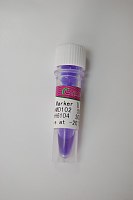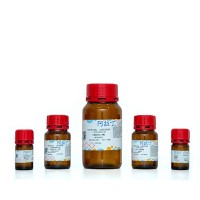Purification of DNA‐Binding Proteins Using Biotin/Streptavidin Affinity Systems
互联网
- Abstract
- Table of Contents
- Materials
- Figures
- Literature Cited
Abstract
Short fragments of DNA?either natural or formed from oligonucleotides?containing a high?affinity site for a DNA?binding protein provide a powerful tool for purification. The biotin/streptavidin purification system is based on the tight and essentially irreversible complex that biotin forms with streptavidin. In this procedure, a DNA fragment is prepared that contains a high?affinity binding site for the protein of interest, and a molecule of biotinylated nucleotide is then incorporated into one of the ends of the DNA fragment. The protein of interest binds to the DNA, and then this complex binds (via the biotin moiety) to the tetrameric protein streptavidin. Next, the protein/biotinylated fragment/streptavidin ternary complex is efficiently isolated by adsorption onto a biotin?containing resin. Since streptavidin is multivalent, it is able to serve as a bridge between the biotinylated DNA fragment and the biotin?containing resin. Proteins remaining in the supernatant are removed by washing, and the resin?bound protein is then eluted with a high?salt buffer. An alternate protocol describes a microcolumn method that is useful for larger volumes of biotin?cellulose resin. This method is also used to elute the protein in as small a volume (i.e., as high a concentration) as possible. Another variation on the basic procedure is provided in which streptavidin?agarose is employed.
Table of Contents
- Alternate Protocol 1: Purification Using a Microcolumn
- Alternate Protocol 2: Purification Using Streptavidin‐Agarose
- Reagents and Solutions
- Commentary
- Figures
Materials
Basic Protocol 1:
Materials
Alternate Protocol 1: Purification Using a Microcolumn
Additional Materials
Alternate Protocol 2: Purification Using Streptavidin‐Agarose
Additional Materials
|
Figures
-

Figure 12.6.1 Purification of DNA‐binding proteins using the biotin/streptavidin affinity technique. The protocol involves the following steps: (1) a biotinylated, labeled DNA fragment is prepared containing a binding site for the protein to be purified; (2) the biotin‐cellulose resin is prepared; (3) a binding reaction containing a crude protein fraction and the biotinylated probe is set up; (4) free streptavidin is added to the binding reaction; (5) the protein/biotinylated DNA fragment/streptavidin complex is bound to the biotin‐cellulose resin; (6) unbound protein is removed by extensive resin washing; and (7) the protein is eluted from the resin with high‐ionic‐strength buffer. Each of these steps can be monitored and optimized in solution, using the mobility shift DNA‐binding assay (see UNIT ). View Image -

Figure 12.6.2 Purification of DNA‐binding proteins using streptavidin‐agarose. View Image
Videos
Literature Cited
| Literature Cited | |
| Chodosh, L.A., Carthew, R.W., and Sharp, P.A. 1986. A single polypeptide possesses the binding and transcription activities of the adenovirus major late promoter. Mol. Cell. Biol. 6:4723‐4733. | |
| Grabowski, P.J. and Sharp, P.A. 1986. Affinity chromatography of splicing complexes: U2, U5, and U4 + U6 small nuclear ribonucleoprotein particles in the spliceosome. Science. 233:1294‐1299. | |
| Haeuptle, M.‐T., Aubert, M.L., Kjiane, J., and Kraehenbuhl, J.‐P. 1983. Binding sites for lactogenic and somatogenic hormones from rabbit mammary gland and liver. J. Biol. Chem. 258:305‐314. | |
| Kadonaga, J.T. and Tjian, R. 1986. Affinity purification of sequence‐specific DNA binding proteins. Proc. Natl. Acad. Sci. U.S.A. 83:5889‐5893. | |
| Kasher, M.S., Pintel, D., and Ward, D.C. 1986. Rapid enrichment of HeLa transcription factors IIIB and IIIC by using affinity chromatography based on avidin‐biotin interactions. Mol. Cell. Biol. 6:3117‐3127. | |
| Rosenfeld, P.J. and Kelly, T.J. 1986. Purification of nuclear factor I by DNA recognition site affinity chromatography. J. Biol. Chem. 261:1398‐1408. | |
| Key References | |
| Chodosh et al., 1986. See above. | |
| Describes the biotin/streptavidin‐agarose microcolumn procedure from which the second alternate protocol of this unit was drawn. | |
| Kasher et al., 1986. See above. | |
| Describes a biotin‐cellulose/streptavidin procedure similar to the of this unit. |







